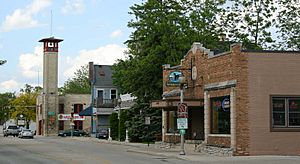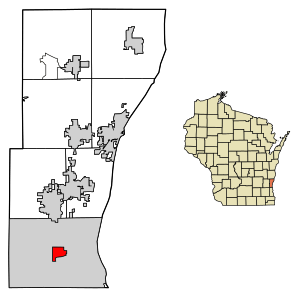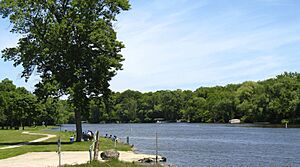Thiensville, Wisconsin facts for kids
Quick facts for kids
Thiensville
|
|
|---|---|

Thiensville's Main Street Historic District
|
|

Location of Thiensville in Ozaukee County, Wisconsin.
|
|
| Country | |
| State | |
| County | Ozaukee |
| Settled | c. 1837 |
| Incorporated | 1910 |
| Area | |
| • Total | 1.08 sq mi (2.79 km2) |
| • Land | 1.04 sq mi (2.69 km2) |
| • Water | 0.04 sq mi (0.10 km2) |
| Elevation | 676 ft (206 m) |
| Population
(2010)
|
|
| • Total | 3,235 |
| • Estimate
(2019)
|
3,125 |
| • Density | 3,010.60/sq mi (1,162.67/km2) |
| Time zone | UTC-6 (Central (CST)) |
| • Summer (DST) | UTC-5 (CDT) |
| Area code(s) | 262 |
| FIPS code | 55-79475 |
| GNIS feature ID | 1575351 |
Thiensville is a small village in Ozaukee County, Wisconsin, United States. It sits on the west bank of the Milwaukee River. The village is completely surrounded by the City of Mequon. It is a suburb that is part of the larger Milwaukee metropolitan area. In 2020, about 3,290 people lived there.
Thiensville was once a Potawatomi village in the early 1800s. White settlers started to arrive in the 1830s and 1840s. Many early settlers were German immigrants. They were part of groups called freethinkers. These groups believed in thinking freely, not following strict religious rules.
One important freethinker was Joachim Heinrich Thien. The village is named after him. Thien helped shape the early politics of the Town of Mequon. He also started the Thiensville Volunteer Fire Department. The freethinkers did not want organized churches in the community. They successfully kept churches out for about 80 years.
Thiensville grew a lot in the late 1800s. It became a stop on the railway. The community became more like a town. It had stores, mills, and services for local farmers. The Village of Thiensville officially became a village in 1910.
After World War II, both Mequon and Thiensville grew quickly. Mequon became a city in 1957. The two communities are very close. They share a chamber of commerce, a library, fire and emergency services, and a school district.
Contents
History of Thiensville
Early Days and Native Americans
In the early 1800s, the Potawatomi people lived in this area. They had a village in what is now Thiensville. It was located near Pigeon Creek. The Potawatomi gave up their land to the U.S. government in 1833. They had to leave the area by 1838.
First Settlers and German Influence
The first white settlers arrived in the mid-1830s. They came from New York, England, and Ireland. John Weston was one of the first. He settled near Thiensville in 1837. He also became the first postmaster for the Town of Mequon.
German immigrants started arriving in 1839. By the 1840s, Germans were the largest group. They made up most of the population in Thiensville and Ozaukee County.
Joachim Heinrich Thien and Freethinkers
Joachim Heinrich Thien moved to the area in 1842. He came from Oldenburg, Prussia. Thien helped plan the settlement that became Thiensville. A year later, he hired Native American workers. They built a dam and a canal on the Milwaukee River. Then, he built a sawmill and a store.
Thien hosted the first town meeting for Mequon in 1846. In 1857, he started the volunteer fire department. He was its first leader.
Thien and many early German settlers were freethinkers. They believed in reason and individual freedom. They did not want formal churches in the village. They succeeded until 1919. That's when St. Cecilia Catholic Church was built.
Growth and Incorporation
Thiensville grew because of the railway. It was built in the early 1870s. In the late 1800s, Thiensville was a busy center. Most of Mequon was rural, but Thiensville had stores, mills, and services. It was like a downtown for the area. The Village of Thiensville officially became a village in 1910. It had 289 people then.
World War II and Modern Ties
In 1945, about 80 German prisoners of war worked in Thiensville. They came from a camp in Little Kohler, Wisconsin. They helped at a canning company. This was because many local men were fighting in World War II. Other German prisoners also worked at a fox ranch nearby.
In the 20th century, Mequon and Thiensville became very close. They share a school district, a chamber of commerce, and a library. In 2023, their fire and emergency services merged. They formed the Southern Ozaukee Fire and Emergency Medical Services Department.
Geography of Thiensville
Location and Size
The village covers about 1.10 square miles (2.79 square kilometers). Most of this area is land. Only a small part is water.
Thiensville is an enclave. This means it is completely surrounded by the City of Mequon. The village is on the north and west bank of a bend in the Milwaukee River. Pigeon Creek also flows through downtown Thiensville. It joins the Milwaukee River near the old village hall. There is a dam on the Milwaukee River upstream from this spot.
Natural Features
The village is in the Southeastern Wisconsin glacial till plains. These plains were formed by the Wisconsin glaciation (ice age). Thiensville is south of the Thiensville formation. This is a large limestone deposit. It is mostly underground.
The Wisconsin Department of Natural Resources says eastern Thiensville is in one ecological area. Western Thiensville is in another. Before settlers arrived, the area had many American beech and sugar maple trees. Most of Thiensville is now developed. Not much of the old forest remains.
Local Wildlife and Plants
The region faces challenges from many invasive species. These are plants and animals that are not native and can harm the environment. Examples include the emerald ash borer (a beetle) and common carp (a fish). Other invasive plants are reed canary grass and purple loosestrife.
Population and People
| Historical population | |||
|---|---|---|---|
| Census | Pop. | %± | |
| 1920 | 334 | — | |
| 1930 | 500 | 49.7% | |
| 1940 | 500 | 0.0% | |
| 1950 | 897 | 79.4% | |
| 1960 | 2,507 | 179.5% | |
| 1970 | 3,182 | 26.9% | |
| 1980 | 3,341 | 5.0% | |
| 1990 | 3,301 | −1.2% | |
| 2000 | 3,254 | −1.4% | |
| 2010 | 3,235 | −0.6% | |
| 2019 (est.) | 3,125 | −3.4% | |
| U.S. Decennial Census | |||
2010 Census Information
In 2010, Thiensville had 3,235 people. There were 1,532 households. A household is a group of people living together. The village had about 2,968 people per square mile.
Most residents were White (93.3%). Other groups included African American (1.7%), Asian (2.1%), and Native American (0.4%). About 2.8% of the population was Hispanic or Latino.
About 24.5% of households had children under 18. Many households (45.6%) were married couples. About 38.5% of households were individuals living alone. The average household had 2.11 people.
The average age in the village was 46.3 years. About 20.8% of residents were under 18. And 21% were 65 or older. The population was 45.8% male and 54.2% female.
Fun Things to Do
Events and Festivals
Thiensville hosts several fun events each year. These include a Memorial Day parade and "Fun Before the Fourth." There is also a public Christmas Tree lighting.
The village has a farmers market. It is held in Village Park every Tuesday. You can visit it from June through October.
The Lions Club puts on an annual Lionfest. This event has a softball tournament, bingo, and live music. It also features carnival rides, a chicken dinner, and a car show.
The Best "Dam" Blues Fest is a two-day music festival. It features blues music.
Library Services
The Frank L. Weyenberg Library serves both Mequon and Thiensville. It is part of the Monarch Library System. This system includes 31 libraries in four counties. In 2018, the library loaned out over 300,000 items.
Places of Worship
Many of Thiensville's first settlers were freethinkers. They worked to keep organized churches out of the community. They succeeded for the first 80 years.
The first church, St. Cecilia Catholic Church, was built in 1919. Later, it merged with another church to form Lumen Christi Catholic Church. As of 2020, Grace Lutheran Church and Christ Alone Evangelical Lutheran Church are in the village. Christ Alone also runs a school for kids from kindergarten to eighth grade.
Parks and Outdoor Activities
Thiensville has several parks for residents to enjoy. These include Molyneux Park and Village Park. There is also a pedestrian riverwalk along the Milwaukee River.
The Ozaukee Interurban Trail runs through the village. This trail is great for walking, running, and biking.
Education in Thiensville
Public Schools
Thiensville's public schools are part of the Mequon-Thiensville School District. Students attend one of two elementary schools: Oriole Lane Elementary or Wilson Elementary. These schools serve students from kindergarten through fifth grade.
All Thiensville students go to Steffen Middle School for grades six through eight. They then attend Homestead High School for grades nine through twelve.
Private Schools
Christ Alone Evangelical Lutheran Church also runs a parochial school in Thiensville. This school serves students from kindergarten through eighth grade.
Village Services
Getting Around
Ozaukee County Transit Services offers a Shared Ride Taxi. This service operates within the county. It also connects to Washington County Transit.
The Wisconsin Central Ltd. railroad operates a freight train line. It runs next to the Ozaukee Interurban Trail in the village.
Safety and Emergency Services
Thiensville's volunteer fire department started in 1857. It was organized by village founder Joachim Heinrich Thien. In 2023, the Mequon and Thiensville fire departments joined together. They formed the Southern Ozaukee Fire and Emergency Medical Services Department. They have stations in Mequon and Thiensville. They also keep the William F. Rausch Fire Museum in the old 1914 Fire Department building.
The village established its full-time police department in 1967. It has seven full-time officers and other staff.
Famous People from Thiensville
- Glenn Grothman: A United States Congressman who represents Wisconsin's 6th congressional district.
- William Carbys Zimmerman: An architect who was born in Thiensville.
Images for kids
See also
 In Spanish: Thiensville (Wisconsin) para niños
In Spanish: Thiensville (Wisconsin) para niños






